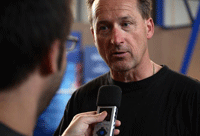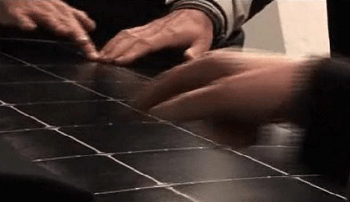“When you took off it was another era. You land in a new era where people understand that with renewable energy you can do impossible things.”
Solar Impulse co-founder Bertrand Piccard to pilot André Borschberg
At 9 AM this morning Swiss time, the Solar Impulse airplane entered the record books by landing — after 26 hours aloft powered only by the sun.
The flight was the culmination of a seven-year long effort by a team of 150 engineers, scientists and other experts, led by project co-founder Bertrand Piccard, the Swiss aviator who made the first non-stop, round-the-world journey in a hot air balloon in 1999.
The Solar Impulse has the wingspan of a jumbo jet (63.4 meters, 208 feet) but weighs about the same as a Honda Accord (1,600 kg, 3527 lbs). The $88 million project has been funded by mostly-Swiss partners and public donations.
After completing the flight over the Jura mountains and Lake Neuchâtel, Swiss pilot André Borschberg described his “extraordinary night” to reporters.
“Just sitting there and watching the battery charge level rise and rise thanks to the sun,” he said, “and then that suspense, not knowing whether we were going to manage to stay up in the air the whole night. And finally the joy of seeing the sun rise and feeling the energy beginning to circulate in the solar panels again. I have just flown more than 26 hours without using a drop of fuel and without causing any pollution.”
Revolutions in solar and battery technology
Piccard credited recent improvements in solar power technology for the successful flight.
“Compared with 2003, energy efficiency has increased from 16 to 22 percent,” said Piccard. “And the cells are now half as thick.”
The ultra-thin solar cells — only 150 microns thick — were developed by leading solar manufacturer SunPower and scientists at Neuchâtel University. The long wings of the Solar Impulse are covered with a skin of 11,000 silicon solar cells.
Swiss chemical giant Solvay worked with South Korean-based Kokam to produce a new lithium polymer battery with an energy density nearly double the previous form. The lighter batteries combined with the lighter solar cells and newly designed ultra-light motors to allow Solar Impulse to generate sufficient electricity during the day to fly and still have enough stored energy to stay aloft during the night.
The solar-powered plane flew at an average speed of 25 mph and climbed to an altitude of 28,000 feet.
Piccard and his team are set to begin work on a new plane. This version will need several improvements to achieve the team’s next goal: flying around the world in five days — broken up into five stages.
The most recent post in the team’s blog celebrates this morning’s event and concludes with these instructions for readers: “You all go off and pick a sunflower, plant it in your yard, and keep the spirit alive. Till the next, fabulous step toward a greener, more sustainable world. Cheers.”
For more on Solar Impulse, see the video below and visit the Solar Impulse website.
Filed under: All,CO2,Intl.,Media,Renewables,Solar
Trackback Uri









